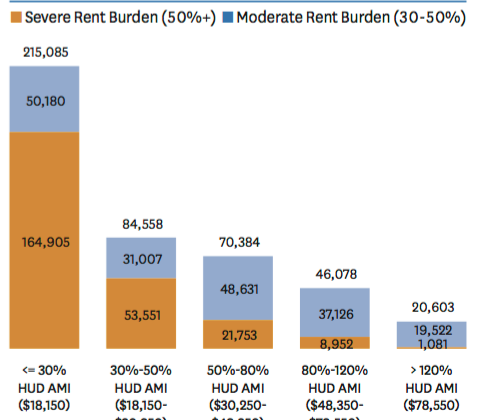An Answer to Stabilizing Rental Markets: Unit Size
Imagine a young adult, fresh out of college and entering into the housing market for the first time. She needs to live close to transit for an internship opportunity downtown, but she is cash strapped. She cannot afford the market rate $1,500 for a studio apartment. She is willing to sacrifice square footage for better affordability, but due to regulation, there are no such housing options. What should she do?
This hypothetical situation is not too uncommon in large urban areas. A study from the Furman Center at NYU found that, “In 2015, more than 436,000 single adults who lived alone in [New York City] were rent burdened, meaning they spent more than 30 percent of their income on rent.” This data shows a clear disconnect between the price of the housing that is available and the financial capabilities of renters. For lower income renters, who rent small units or have roommates at high rates, this disconnect is especially painful. This is due to the fact that there are “a total of only 210,000 small units, in comparison to the nearly 1.2 million renters living alone or with unrelated roommates in the city.”
So what is the solution to this dilemma? Would allowing the construction of smaller units truly help this rent crisis? Some people may argue that smaller units won’t help the market, as units are already trending towards smaller sizes, yet rents still continue to increase. I disagree. Financial modeling published as part of the Furman Center study concluded that constructing smaller units does, in fact, lead to less rent. This financial modeling compared studio apartments to micro units and efficiency unit models. It found that construction of smaller units definitely helps with rent burden.
A small studio unit requires rent of approximately $1,480 per month to support construction… an efficiency unit with shared kitchen and bath would require a rent of approximately $840 per month.
It is important to acknowledge that not all people struggling with housing costs are single people who are able to live in small units. But as the Furman study shows, the number of people who are single and can benefit is large and significant. Allowing the market to solve this segment’s problem means they won’t need subsidies and that means those dollars can help families and other who have different needs.
It is true that recently, rental square footage has gone down, on average, while rents have gone up. But this is a macroeconomic measurement. Such a measurement is very broad and ignores the fact that due to other market forces, rents would probably be even higher if units had stayed at the same size. Policymakers nationwide should know how much smaller units could help the market as they contemplate how to solve the current affordable housing crisis; They should be aware of the monumental impact smaller units can have on rent affordability and the stabilization of the rent market.
Ari Webb is a high school student who is interested in public policy, especially the Seattle housing crisis and believes that increasing housing supply is the most effective way of extending affordable housing to people of all income levels.


